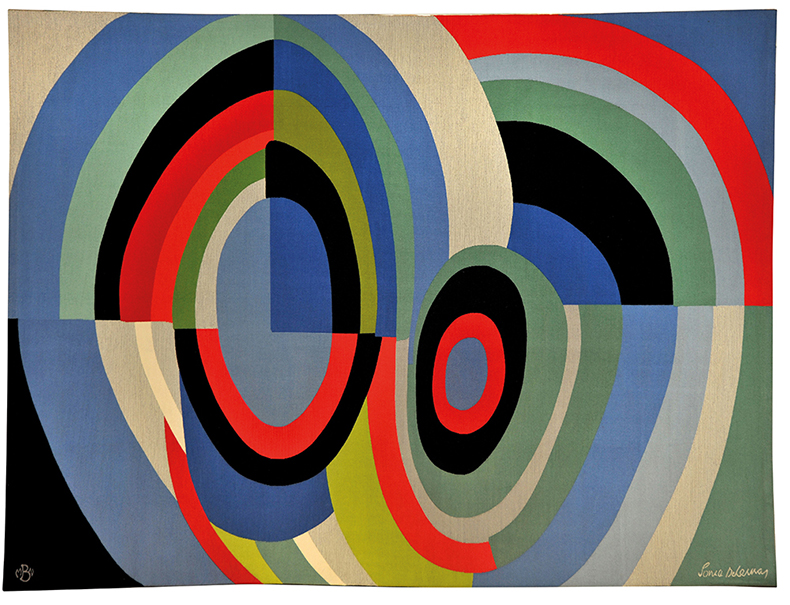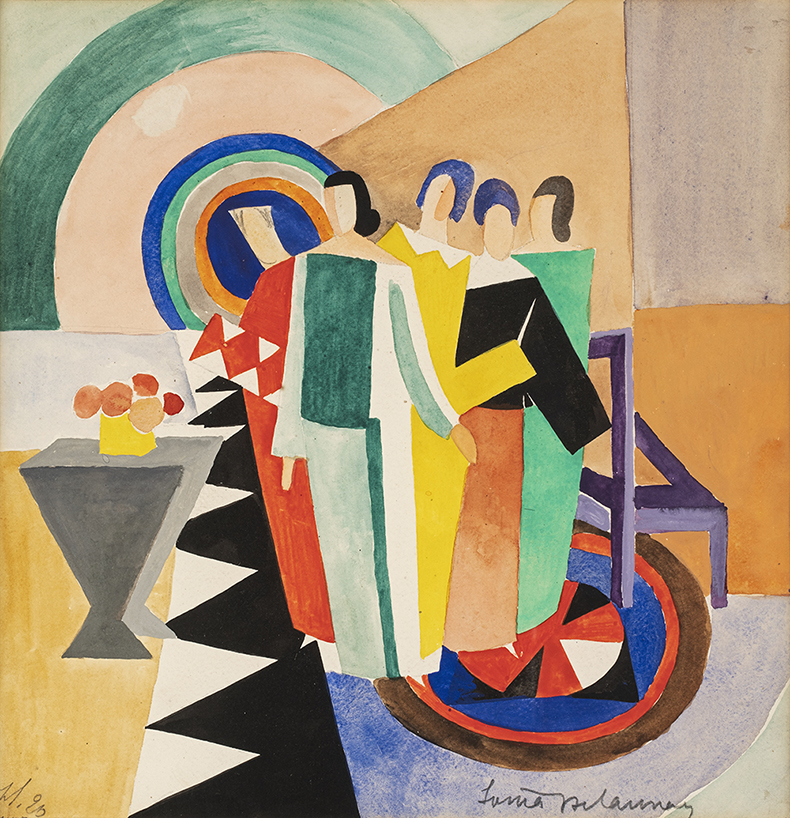From the April 2024 issue of Apollo. Preview and subscribe now.
‘I still have a lot of things to do today,’ were the dying words of Sonia Delaunay – paintbrushes still at the ready – in 1979 at the age of 94. Born in Odesa and based in Paris for most of her life, the artist and designer enjoyed an extraordinarily productive seven-decade career. Not even two world wars slowed her down much. In her lifetime, she was the subject of major retrospectives, and much of her art and archival materials have ended up well preserved in institutional hands. Scholars have never tired of mining the Soniaverse. The Bard Graduate Center has illuminated it by borrowing about 200 of her artworks and objects from dozens of private and public lenders.
The show sheds light on her family origins, a subject that she barely discussed. Delaunay was born Sara Elievna Stern to a working-class Jewish family. As a little girl she was adopted by her wealthy, childless aunt and uncle, Anna and Genrikh Terk, who lived in St Petersburg. Sara became Sonia Terk, enjoying wide travels and private tutoring. She knew that she was privileged to avoid the pogroms that devastated Jewish communities further down the socio-economic ladder. The exhibition catalogue quotes teenage Sonia’s diary description of persecuted Jews: ‘the people I belong to, but which I do not know at all.’

Rythmes couleurs ou Panneau F 1898 (1975), Sonia Delaunay. Mobilier national, Paris. Photo: Isabelle Bideau; © Pracusa
By her mid 20s, Sonia had finished formal art training at schools in Karlsruhe and Paris and ended a brief marriage to Wilhelm Uhde, a gay, German-Jewish art dealer based in Paris. She was already pregnant in late 1910 when she married her soulmate, the abstract painter Robert Delaunay. ‘When the Delaunays wake up they talk painting,’ observed the newlyweds’ friend, the poet Guillaume Apollinaire, at the outset of their romance. The birth of their only child, Charles, inspired Sonia to stitch a crib quilt with irregular squares, rectangles and triangles of mismatched fabrics. She considered it a crucial stepping stone in the development of her art, which would be characterised by geometric forms in complementary and contrasting hues.
Robert heartily supported his wife’s career, praising her ‘atavistic understanding of colour’. She became the family breadwinner, turning her design skills to playing cards, sports cars and party dresses among other tasks. But that was not her original intent, as she explained in a documentary by her mentee Patrick Raynaud in 1972. ‘I made everything to amuse myself,’ she said.
During the First World War, the Delaunays found refuge in Spain and Portugal. Sonia ran an interior design workshop, supplying polychrome furnishings for residential and commercial interiors, down to the lampshades and tableware. She hoped to banish any trace of what she called ‘quotidian banality’ from her customers’ rooms.

Sonia Delaunay at Boulevard Malesherbes (c. 1925). Bibliothèque nationale de France, Paris
In the 1920s and ’30s, her Paris-based fashion house produced textiles and clothing, teeming with dots, arcs, chevrons and embroidered quotes from avant-garde poets such as Tristan Tzara. As her customers returned week after week for laborious tailoring sessions, Sonia ignored business advice to adapt her products for mass marketing and she fell deeply into debt.
Soon after the Nazis occupied France, Robert died of cancer. Sonia survived the war as a nomad, mostly in southern France, in the company of other uprooted artists such as Sophie Taeuber-Arp. (Several of their friends, it turns out, were moonlighting as French Resistance agents.) Sonia fended off terror and loneliness by writing copiously in her diaries, painting abstract gouaches and taking train rides and long walks with her tawny long-haired cat Minouche. Who would suspect that this eccentric with a slight Slavic accent was Jewish and on the run? Her possessions and her son – who also worked for the Resistance – remained in Paris, relatively unscathed.

Groupe de femmes (1925), Sonia Delaunay. Galerie Zlotowski, Paris. © Pracusa
After the Second World War, Delaunay re-emerged to growing acclaim. She became more versatile in her work, exploring jewellery, stained glass, tapestry and porcelain, in collaboration with companies including Dior. Academics, journalists, servants, film-makers and protégés thronged her Left Bank duplex apartment. Into her 90s, she could be found still painting, dressed in her customary blue tweed suits from Chanel. ‘She was a magnificent lioness,’ Raynaud writes in the catalogue.
On the museum’s top floor, the contemporary book artist Kitty Maryatt displays a toolkit for printing replicas of a two-metre-long nonsensical poem by Blaise Cendrars from 1913. Delaunay decorated the original, splashing around 70 different colours along its accordion folds. Maryatt’s equipment includes boar-hair brushes and aluminium stencils in amoeboid forms.
Raynaud’s documentary is 23 minutes long, with a cacophonous soundtrack, spinning images and minimal captions. It can be maddening and vertigo-inducing. But it is worth watching in its entirety, since its subject – then in her 80s – comes across as so impatient. ‘I still have a lot to learn and to refine,’ she tells the interviewer. ‘I am in a hurry to work.’
‘Sonia Delaunay: Living Art’ is at the Bard Graduate Center, New York, until 7 July.
From the April 2024 issue of Apollo. Preview and subscribe now.














![Masterpiece [Re]discovery 2022. Photo: Ben Fisher Photography, courtesy of Masterpiece London](http://zephr.apollo-magazine.com/wp-content/uploads/2022/07/MPL2022_4263.jpg)
Why it’s time to stop rediscovering Eileen Gray